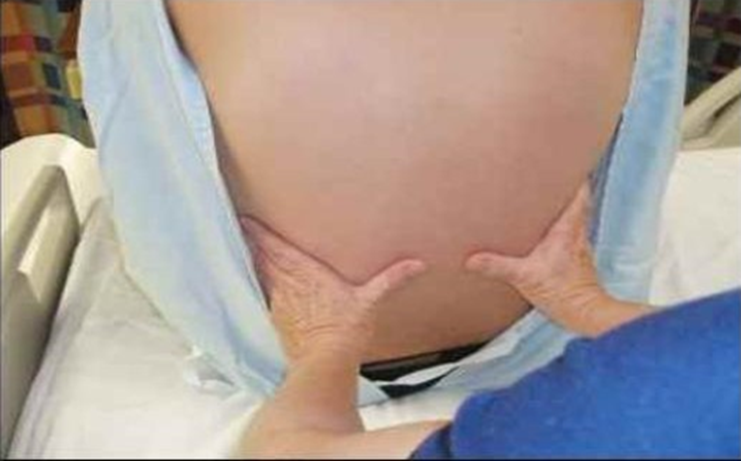The nurse continues the respiratory assessment of a client's chest excursion by placing both hands as seen in the picture. Which instruction should the nurse give the client?

Hold your breath.
Take a deep breath
Cough vigorously
Lean forward.
The Correct Answer is B
A. Hold your breath: Holding the breath would prevent the nurse from observing chest movement during inhalation and exhalation, making it unsuitable for assessing chest excursion.
B. Chest excursion is assessed to evaluate the symmetry and depth of lung expansion. By instructing the client to take a deep breath, the nurse can observe the movement of both hands as the lungs expand. Symmetrical and adequate movement indicates normal lung function, while asymmetry may suggest conditions such as pneumothorax, pleural effusion, or atelectasis.
C. Cough vigorously: While coughing may be helpful in evaluating airway clearance or adventitious sounds, it is unrelated to chest excursion.
D. Lean forward: Leaning forward is not necessary for chest excursion assessment; this position is typically used for auscultating posterior lung sounds or relieving dyspnea in conditions like COPD.
Nursing Test Bank
Naxlex Comprehensive Predictor Exams
Related Questions
Correct Answer is B
Explanation
A. Pneumonia would typically present with fever, chills, productive cough, and consolidation on physical exam.
B. The client's symptoms, such as trouble breathing, tightness in the chest, wheezing on expiration, prolonged expirations, and low oxygen saturation, suggest an acute asthma exacerbation. Asthma is often triggered by exercise and is characterized by wheezing, tightness in the chest, and difficulty breathing.
C. Bronchitis would present with a persistent cough and sputum production, not necessarily with wheezing and a drop in oxygen saturation.
D. Pneumothorax presents with sudden chest pain and dyspnea, often with a collapsed lung on one side, leading to unequal breath sounds and a shift in the mediastinum.
Correct Answer is B
Explanation
A. Hold your breath: Holding the breath would prevent the nurse from observing chest movement during inhalation and exhalation, making it unsuitable for assessing chest excursion.
B. Chest excursion is assessed to evaluate the symmetry and depth of lung expansion. By instructing the client to take a deep breath, the nurse can observe the movement of both hands as the lungs expand. Symmetrical and adequate movement indicates normal lung function, while asymmetry may suggest conditions such as pneumothorax, pleural effusion, or atelectasis.
C. Cough vigorously: While coughing may be helpful in evaluating airway clearance or adventitious sounds, it is unrelated to chest excursion.
D. Lean forward: Leaning forward is not necessary for chest excursion assessment; this position is typically used for auscultating posterior lung sounds or relieving dyspnea in conditions like COPD.
Whether you are a student looking to ace your exams or a practicing nurse seeking to enhance your expertise , our nursing education contents will empower you with the confidence and competence to make a difference in the lives of patients and become a respected leader in the healthcare field.
Visit Naxlex, invest in your future and unlock endless possibilities with our unparalleled nursing education contents today
Report Wrong Answer on the Current Question
Do you disagree with the answer? If yes, what is your expected answer? Explain.
Kindly be descriptive with the issue you are facing.
